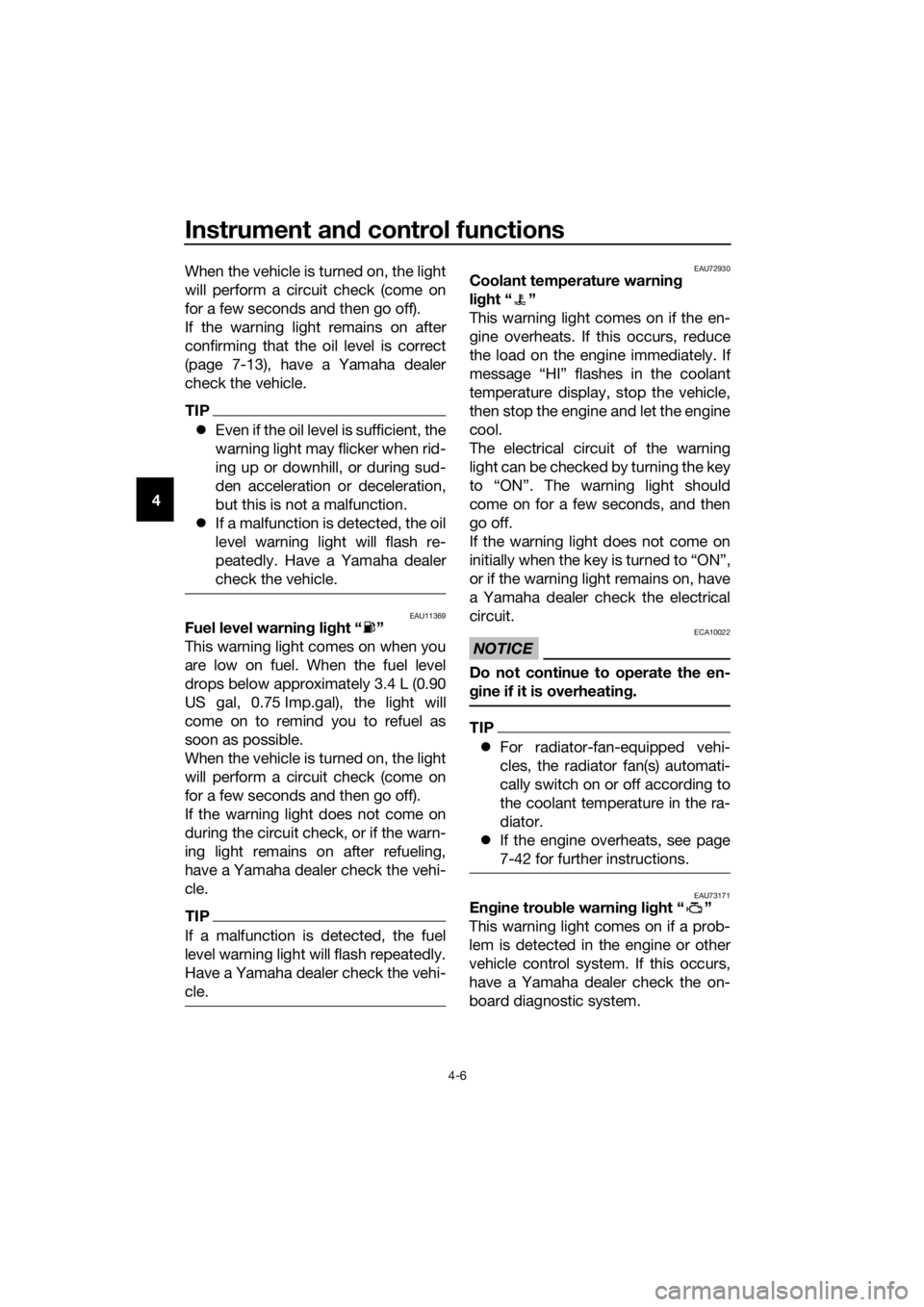check engine YAMAHA YZF-R6 2017 Owners Manual
[x] Cancel search | Manufacturer: YAMAHA, Model Year: 2017, Model line: YZF-R6, Model: YAMAHA YZF-R6 2017Pages: 114, PDF Size: 4.2 MB
Page 5 of 114

Table of contents
Safety information ............................1-1
Description ........................................2-1
Left view ..........................................2-1
Right view........................................2-2
Controls and instruments ................2-3
Special features ................................3-1
D-mode (drive mode) ......................3-1
Traction control system...................3-2
Quick shift system ...........................3-4
Instrument an d control functions ....4-1
Immobilizer system .........................4-1
Main switch/steering lock ...............4-2
Handlebar switches.........................4-4
Indicator lights and warning
lights ............................................4-5
Multi-function meter unit .................4-8
Clutch lever ...................................4-17
Shift pedal .....................................4-17
Brake lever ....................................4-18
Brake pedal ...................................4-18
ABS ...............................................4-19
Fuel tank cap.................................4-20
Fuel................................................4-20
Fuel tank overflow hose ................4-22
Catalytic converters .....................4-22
Seats .............................................4-23
Rear view mirrors ..........................4-24
Adjusting the front fork..................4-25
Adjusting the shock absorber assembly....................................4-27
EXUP system ................................4-29
Auxiliary DC connector .................4-30
Sidestand ......................................4-30
Ignition circuit cut-off system........4-31
For your safety – pre-operation
checks ...............................................5-1
Operation an d important ri din g
points .................................................6-1
Starting the engine ..........................6-2
Shifting ............................................6-3 Tips for reducing fuel
consumption................................ 6-4
Engine break-in ............................... 6-4
Parking ............................................ 6-5
Perio dic maintenance an d
a d justment ........................................ 7-1
Owner’s tool kit ............................... 7-2
Periodic maintenance chart for the
emission control system.............. 7-3
General maintenance and
lubrication chart........................... 7-4
Removing and installing cowlings and panels ................................... 7-7
Checking the spark plugs ............. 7-11
Canister......................................... 7-12
Engine oil and oil filter cartridge ... 7-13
Coolant ......................................... 7-17
Air filter element ............................ 7-19
Checking the engine idling speed......................................... 7-20
Checking the throttle grip free play ............................................ 7-20
Valve clearance ............................. 7-21
Tires .............................................. 7-21
Cast wheels .................................. 7-24
Adjusting the clutch lever free play ............................................ 7-24
Checking the brake lever free
play ............................................ 7-25
Brake light switches ...................... 7-26
Checking the front and rear brake pads................................. 7-26
Checking the brake fluid level....... 7-27
Changing the brake fluid............... 7-28
Drive chain slack ........................... 7-29
Cleaning and lubricating the drive chain ................................. 7-30
Checking and lubricating the cables ........................................ 7-31
Checking and lubricating the
throttle grip and cable ............... 7-31
Checking and lubricating the brake and shift pedals ............... 7-32
Checking and lubricating the
brake and clutch levers ............. 7-32
UBN6E0E0.book Page 1 Wednesday, January 25, 2017 1:28 PM
Page 9 of 114

Safety information
1-3
1
Avoi
d Car bon Monoxi de Poisonin g
All engine exhaust contains carbon
monoxide, a deadly gas. Breathing
carbon monoxide can cause head-
aches, dizziness, drowsiness, nausea,
confusion, and eventually death.
Carbon Monoxide is a colorless, odor-
less, tasteless gas which may be pres-
ent even if you do not see or smell any
engine exhaust. Deadly levels of car-
bon monoxide can collect rapidly and
you can quickly be overcome and un-
able to save yourself. Also, deadly lev-
els of carbon monoxide can linger for
hours or days in enclosed or poorly
ventilated areas. If you experience any
symptoms of carbon monoxide poi-
soning, leave the area immediately, get
fresh air, and SEEK MEDICAL TREAT-
MENT. Do not run engine indoors. Even if
you try to ventilate engine exhaust
with fans or open windows and
doors, carbon monoxide can rap-
idly reach dangerous levels.
Do not run engine in poorly venti-
lated or partially enclosed areas
such as barns, garages, or car-
ports.
Do not run engine outdoors where
engine exhaust can be drawn into
a building through openings such
as windows and doors.
Loa din g
Adding accessories or cargo to your
motorcycle can adversely affect stabil-
ity and handling if the weight distribu-
tion of the motorcycle is changed. To
avoid the possibility of an accident, use
extreme caution when adding cargo or
accessories to your motorcycle. Use extra care when riding a motorcycle
that has added cargo or accessories.
Here, along with the information about
accessories below, are some general
guidelines to follow if loading cargo to
your motorcycle:
The total weight of the operator, pas-
senger, accessories and cargo must
not exceed the maximum load limit.
Operation of an overloa
ded vehicle
coul d cause an acci dent.
When loading within this weight limit,
keep the following in mind: Cargo and accessory weight
should be kept as low and close to
the motorcycle as possible. Se-
curely pack your heaviest items as
close to the center of the vehicle
as possible and make sure to dis-
tribute the weight as evenly as
possible on both sides of the mo-
torcycle to minimize imbalance or
instability.
Shifting weights can create a sud-
den imbalance. Make sure that
accessories and cargo are se-
curely attached to the motorcycle
before riding. Check accessory
mounts and cargo restraints fre-
quently.
• Properly adjust the suspension for your load (suspension-ad-
justable models only), and
check the condition and pres-
sure of your tires.
• Never attach any large or heavy items to the handlebar, front
fork, or front fender. These
items, including such cargo as
Maximum loa d:
185 kg (408 lb)
UBN6E0E0.book Page 3 Wednesday, January 25, 2017 1:28 PM
Page 11 of 114

Safety information
1-5
1
operator and may limit control
ability, therefore, such accesso-
ries are not recommended.
Use caution when adding electri-
cal accessories. If electrical ac-
cessories exceed the capacity of
the motorcycle’s electrical sys-
tem, an electric failure could re-
sult, which could cause a
dangerous loss of lights or engine
power.
Aftermarket Tires an d Rims
The tires and rims that came with your
motorcycle were designed to match
the performance capabilities and to
provide the best combination of han-
dling, braking, and comfort. Other
tires, rims, sizes, and combinations
may not be appropriate. See page 7-21
for tire specifications and for informa-
tion on servicing and replacing your
tires.
Transportin g the Motorcycle
Be sure to observe following instruc-
tions before transporting the motorcy-
cle in another vehicle. Remove all loose items from the
motorcycle.
Check that the fuel cock (if
equipped) is in the off position and
that there are no fuel leaks.
Shift the transmission into gear
(for models with a manual trans-
mission).
Secure the motorcycle with tie-
downs or suitable straps that are
attached to solid parts of the mo-
torcycle, such as the frame or up-
per front fork triple clamp (and not,
for example, to rubber-mounted handlebars or turn signals, or
parts that could break). Choose
the location for the straps carefully
so the straps will not rub against
painted surfaces during transport.
The suspension should be com-
pressed somewhat by the tie-
downs, if possible, so that the mo-
torcycle will not bounce exces-
sively during transport.
UBN6E0E0.book Page 5 Wednesday, January 25, 2017 1:28 PM
Page 24 of 114

Instrument and control functions
4-6
4 When the vehicle is turned on, the light
will perform a circuit check (come on
for a few seconds and then go off).
If the warning light remains on after
confirming that the oil level is correct
(page 7-13), have a Yamaha dealer
check the vehicle.
TIP
Even if the oil level is sufficient, the
warning light may flicker when rid-
ing up or downhill, or during sud-
den acceleration or deceleration,
but this is not a malfunction.
If a malfunction is detected, the oil
level warning light will flash re-
peatedly. Have a Yamaha dealer
check the vehicle.
EAU11369Fuel level warnin g lig ht “ ”
This warning light comes on when you
are low on fuel. When the fuel level
drops below approximately 3.4 L (0.90
US gal, 0.75 Imp.gal), the light will
come on to remind you to refuel as
soon as possible.
When the vehicle is turned on, the light
will perform a circuit check (come on
for a few seconds and then go off).
If the warning light does not come on
during the circuit check, or if the warn-
ing light remains on after refueling,
have a Yamaha dealer check the vehi-
cle.
TIP
If a malfunction is detected, the fuel
level warning light will flash repeatedly.
Have a Yamaha dealer check the vehi-
cle.
EAU72930Coolant temperature warnin g
li g ht “ ”
This warning light comes on if the en-
gine overheats. If this occurs, reduce
the load on the engine immediately. If
message “HI” flashes in the coolant
temperature display, stop the vehicle,
then stop the engine and let the engine
cool.
The electrical circuit of the warning
light can be checked by turning the key
to “ON”. The warning light should
come on for a few seconds, and then
go off.
If the warning light does not come on
initially when the key is turned to “ON”,
or if the warning light remains on, have
a Yamaha dealer check the electrical
circuit.
NOTICE
ECA10022
Do not continue to operate the en-
g ine if it is overheatin g.
TIP
For radiator-fan-equipped vehi-
cles, the radiator fan(s) automati-
cally switch on or off according to
the coolant temperature in the ra-
diator.
If the engine overheats, see page
7-42 for further instructions.
EAU73171Engine trou ble warnin g lig ht “ ”
This warning light comes on if a prob-
lem is detected in the engine or other
vehicle control system. If this occurs,
have a Yamaha dealer check the on-
board diagnostic system.
UBN6E0E0.book Page 6 Wednesday, January 25, 2017 1:28 PM
Page 25 of 114

Instrument and control functions
4-7
4
The electrical circuit of the warning
light can be checked by turning the key
to “ON”. The warning light should
come on for a few seconds, and then
go off.
If the warning light does not come on
initially when the key is turned to “ON”,
or if the warning light remains on, have
a Yamaha dealer check the vehicle.
EAU69891ABS warnin
g li ght “ ”
In normal operation, this warning light
comes on when the key is turned to
“ON”, and goes off after traveling at a
speed of 10 km/h (6 mi/h) or higher.
If the ABS warning light: does not come on when the key is
turned to “ON”
comes on or flashes while riding
does not go off after traveling at a
speed of 10 km/h (6 mi/h) or high-
er
The ABS may not work correctly. If any
of the above occurs, have a Yamaha
dealer check the system as soon as
possible. (See page 4-19 for an expla-
nation of the ABS.)
WARNING
EWA16041
If the ABS warnin g li ght does not go
off after travelin g at a speed of 10
km/h (6 mi/h) or hi gher, or if the
warnin g li ght comes on or flashes
while ri din g, the b rake system re-
verts to conventional brakin g. If ei-
ther of the ab ove occurs, or if the
warnin g li ght does not come on at
all, use extra caution to avoid possi-
b le wheel lock durin g emer gency b
rakin g. Have a Yamaha d ealer
check the brake system an d electri-
cal circuits as soon as possi ble.
EAU77002Traction control system in dicator
li g ht “ ”
This indicator light flashes when trac-
tion control has engaged. If the traction
control system is turned off, the indica-
tor light will come on.
When the vehicle is turned on, the light
will perform a circuit check (come on
for a few seconds and then go off). If
the light does not come on during the
circuit check, or if the light remains on,
Yamaha dealer check the vehicle.
EAU80370Shift li ght
This light can be set to come on and go
off at select engine speeds. (See page
4-15.)
When the vehicle is turned on, the light
will perform a circuit check (come on
for a few seconds and then go off).
If the light does not come on during the
circuit check, have a Yamaha dealer
check the vehicle.
EAU80300Immo bilizer system in dicator li ght
When the key is turned to “OFF” and
30 seconds have passed, the indicator
light will flash steadily to indicate the
immobilizer system is enabled. After 24
hours have passed, the indicator light
will stop flashing, however the immobi-
lizer system is still enabled.
The electrical circuit of the indicator
light can be checked by turning the key
to “ON”. The indicator light should
come on for a few seconds, and then
go off.
ABS
UBN6E0E0.book Page 7 Wednesday, January 25, 2017 1:28 PM
Page 26 of 114

Instrument and control functions
4-8
4 If the indicator light does not come on
initially when the key is turned to “ON”,
if the indicator light remains on, or if the
indicator light flashes in a pattern (if a
problem is detected in the immobilizer
system, the immobilizer system indica-
tor light will flash in a pattern), have a
Yamaha dealer check the vehicle.
TIP
If the immobilizer system indicator light
flashes in the pattern, slowly 5 times
then quickly 2 times, this could be
caused by transponder interference. If
this occurs, try the following.
1. Make sure there are no other im- mobilizer keys close to the main
switch. Other immobilizer system
keys may cause signal interfer-
ence and prevent the engine from
starting.
2. Use the code re-registering key to start the engine.
3. If the engine starts, turn it off, and try starting the engine with the
standard keys.
4. If one or both of the standard keys do not start the engine, take the
vehicle and all 3 keys to a Yamaha
dealer to have the standard keys
re-registered.
EAU3904F
Multi-function meter unit
WARNING
EWA12423
Be sure to stop the vehicle before
makin g any settin g chan ges to the
multi-function meter unit. Chang ing
settin gs while ri din g can d istract the
operator an d increase the risk of an
acci dent.
The multi-function meter unit is
equipped with the following:
speedometer
tachometer
clock
lap timer
coolant temperature display
air intake temperature display
transmission gear display
drive mode display
TCS display
1. Tachometer
2. Shift light
3. TCS display
4. Coolant/air intake temperature display
5. Quick shift icon “QS”
6. Drive mode display
7. Speedometer
8. Multi-function display
9. Clock/lap timer
10.Transmission gear display
11.“RESET” button
12.“SELECT” button
6
5
7
8
9
2
34
101112
1
UBN6E0E0.book Page 8 Wednesday, January 25, 2017 1:28 PM
Page 39 of 114

Instrument and control functions
4-21
4
3. Wipe up any spilled fuel immedi-
ately. NOTICE: Immediately
wipe off spille d fuel with a clean,
d ry, soft cloth, since fuel may
d eteriorate painte d surfaces or
plastic parts.
[ECA10072]
4. Be sure to securely close the fuel tank cap.
WARNING
EWA15152
Gasoline is poisonous an d can cau-
se injury or death. Han dle gasoline
with care. Never siphon gasoline by
mouth. If you shoul d swallow some
g asoline or inhale a lot of g asoline
vapor, or get some g asoline in your
eyes, see your doctor imme diately. If
g asoline spills on your skin, wash
with soap an d water. If gasoline
spills on your clothin g, chan ge your
clothes.
EAU75320
NOTICE
ECA11401
Use only unlea ded g asoline. The use
of lead ed g asoline will cause severe
d ama ge to internal en gine parts,
such as the valves an d piston rin gs,
as well as to the exhaust system.
TIP
This mark identifies the recom-
mended fuel for this vehicle as
specified by European regulation
(EN228).
Check that gasoline nozzle has
the same identifier when fueling.
Your Yamaha engine has been de-
signed to use premium unleaded gas-
oline with a research octane number of
95 or higher. If knocking (or pinging)
occurs, use a gasoline of a different
brand. Use of unleaded fuel will extend
spark plug life and reduce mainte-
nance costs.
Gasohol
There are two types of gasohol: gaso-
hol containing ethanol and that con-
taining methanol. Gasohol containing
ethanol can be used if the ethanol con-
tent does not exceed 10% (E10). Gas-
ohol containing methanol is not
recommended by Yamaha because it
can cause damage to the fuel system
or vehicle performance problems.
Recommen ded fuel:
Premium unleaded gasoline (Gaso-
hol [E10] acceptable)
Fuel tank capacity: 17 L (4.5 US gal, 3.7 Imp.gal)
Fuel reserve amount (when the fuel
level warnin g lig ht comes on):
3.4 L (0.90 US gal, 0.75 Imp.gal)
E10
UBN6E0E0.book Page 21 Wednesday, January 25, 2017 1:28 PM
Page 47 of 114

Instrument and control functions
4-29
4
TIP
Although a damping force adjuster
may turn or click beyond the stated mi-
nimum settings, such adjustments are
ineffective and may damage the sus-
pension.
WARNING
EWA10222
This shock ab sorber assem bly con-
tains hi ghly pressurize d nitro gen
g as. Read and un derstan d the fol-
lowin g information before han dlin g
the shock a bsor ber assem bly.
Do not tamper with or attempt
to open the cylind er assembly.
Do not su bject the shock a b-
sor ber assem bly to an open
flame or other hi gh heat source.
This may cause the unit to ex-
plo de due to excessive g as
pressure.
Do not deform or damag e the
cylin der in any way. Cylin der
d amag e will result in poor
d ampin g performance.
Do not d ispose of a damag ed or
worn-out shock a bsor ber as-
sem bly
yourself. Take the shock
a b sor ber assem bly to a Yamaha
d ealer for any service.
EAU15283
EXUP system
This model is equipped with Yamaha’s
EXUP (EXhaust Ultimate Power valve)
system. This system boosts engine
power by means of a valve that regu-
lates the inner diameter of the exhaust
pipe. The EXUP system valve is con-
stantly adjusted in accordance with the
engine speed by a computer-con-
trolled servomotor.
NOTICE
ECA10192
The EXUP system has been set
an d extensively teste d at the
Yamaha factory. Chan gin g
these settin gs without sufficient
technical knowle dge may result
in poor performance of or dam-
a g e to the en gine.
If the EXUP system cannot be
hear d when the main switch is
turne d on, have a Yamaha deal-
er check it.
Slow compression dampin g settin g
Minimum (soft): 18 click(s) in direction (b)*
Standard:
14 click(s) in direction (b)*
Maximum (hard): 1 click(s) in direction (b)*
* With the adjusting bolt fully turned in direction (a)
UBN6E0E0.book Page 29 Wednesday, January 25, 2017 1:28 PM
Page 49 of 114

Instrument and control functions
4-31
4
EAU64050
Ig nition circuit cut-off system
The ignition circuit cut-off system
(comprising the sidestand switch,
clutch switch and neutral switch) has
the following functions.
It prevents starting when the
transmission is in gear and the
sidestand is up, but the clutch le-
ver is not pulled.
It prevents starting when the
transmission is in gear and the
clutch lever is pulled, but the side-
stand is still down.
It cuts the running engine when
the transmission is in gear and the
sidestand is moved down.
Periodically check the operation of the
ignition circuit cut-off system accord-
ing to the following procedure.
UBN6E0E0.book Page 31 Wednesday, January 25, 2017 1:28 PM
Page 50 of 114

Instrument and control functions
4-32
4
With the engine turned off:
1. Move the sidestand down.
2.
Make sure that the start/engine stop
switch is set to “ ”.
3. Turn the key on.
4. Shift the transmission into the neutral position.
5.
Push the “ ” side of the start/engine
stop switch.
Does the engine start?
With the engine still running:
6. Move the sidestand up.
7. Keep the clutch lever pulled.
8. Shift the transmission into gear.
9. Move the sidestand down.
Does the engine stall?
After the engine has stalled:
10. Move the sidestand up.
11. Keep the clutch lever pulled.
12.
Push the “ ” side of the
start/engine stop switch.
Does the engine start?
The system is OK. The motorcycle can
be ridden.
The neutral switch may not be working
correctly.
The motorcycle should not be ridden
until checked by a Yamaha dealer.
The sidestand switch may not be
working correctly.
The motorcycle should not be ridden
until checked by a Yamaha dealer.
The clutch switch may not be working
correctly.
The motorcycle should not be ridden
until checked by a Yamaha dealer.
WARNING
If a malfunction is noted, have a
Yamaha dealer check the system
before riding.
YES NO
YESNO
YESNO
UBN6E0E0.book Page 32 Wednesday, January 25, 2017 1:28 PM